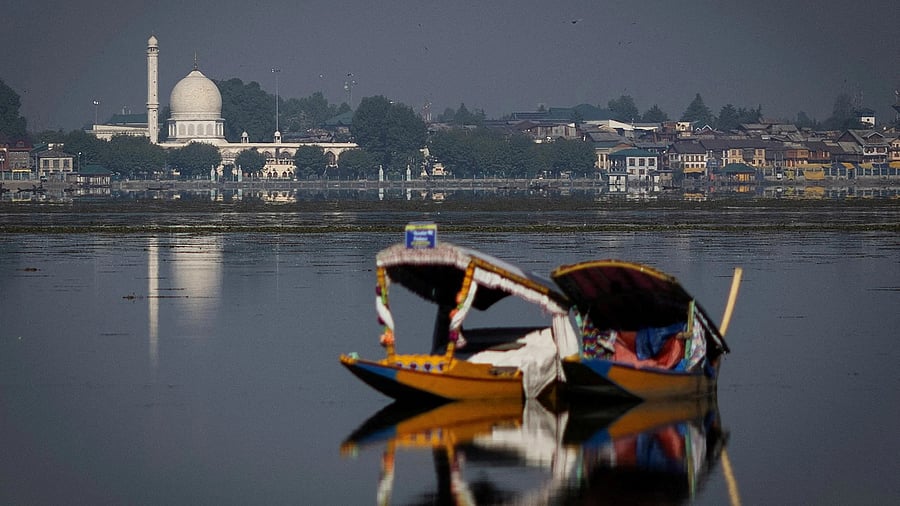
A traditional Shikara boat is seen in the waters of Dal Lake as the Hazratbal shrine is seen in the background in Srinagar, Kashmir.
Credit: Reuters photo
From the disappearance of Prophet Mohammad’s holy relic in 1963 to the siege of 1993, the burning of Chrar-e-Sharif in 1995, and the emblem row of 2025, Kashmir’s most revered shrines have repeatedly been drawn into the vortex of politics and conflict.
Each controversy has chipped away at their sanctity, turning places of prayer into stages for propaganda, power struggles, and identity wars.
The Hazratbal shrine on the banks of Dal Lake, the spiritual heart of Kashmir’s Sufi Islam, has particularly borne this burden. For devotees, Hazratbal is a place of tears, humility and connection with the last Prophet of Islam through the Moi-e-Muqaddas (the holy relic).
For terrorists, separatists, and mainstream politicians, it has too often become a convenient tool.
The relic agitation of 1963: The first storm came in December 1963, when the relic of the Prophet went missing. The Valley erupted in unprecedented protests, paralysing the state until the relic was mysteriously recovered 15 days later. Faith had been shaken, but politics reaped the dividends. The agitation toppled Bakshi Ghulam Mohammad and brought G M Sadiq to power. Ordinary people mourned the sacrilege, yet the real beneficiary was political change. Even today, questions linger over whose house the relic was found in and whether its disappearance was accidental or a calculated ploy to reshape Kashmir’s politics.
Hazratbal under siege in 1993: The most prolonged and tense episode in Hazratbal’s modern history unfolded in October 1993, when armed terrorists took refuge inside the shrine, forcing security forces into a weeks-long standoff. For the state, storming Hazratbal was unthinkable—it housed the Prophet’s relic, and any damage could have set the Valley ablaze. For the terrorists, this was precisely the point: by hiding in Hazratbal, they sought to provoke sacrilege and convert religious fervour into political capital.
The siege drew international attention. Global media portrayed Hazratbal as a sacred shrine under siege, while separatist groups cast the terrorists as “defenders of faith.” Within Kashmir, rumours spread that the relic itself was endangered, triggering mass protests. For the faithful, the sight of their holiest shrine ringed with bunkers and barbed wire was a wound. For separatists, it became propaganda gold. For the state, it was a grim lesson in how faith could be weaponised at the height of insurgency.
The flames of Chrar-e-Sharif, 1995: Just two years later, another Sufi shrine was dragged into violence. In 1995, Pakistani terrorist commander Mast Gul and his men occupied the 600-year-old shrine of Sheikh Noor-ud-din Noorani at Chrar-e-Sharif. The ensuing battle reduced the shrine to ashes. Together, Hazratbal and Chrar revealed how terrorists and separatists exploited Kashmir’s spiritual heritage.
The emblem row of 2025: The latest storm arose not from a relic or a siege, but from a plaque. Earlier this month, the Jammu and Kashmir Waqf Board installed a marble slab bearing the Ashoka emblem inside Hazratbal. To many devotees, it seemed unnecessary. To politicians, it was an opportunity.
National Conference leader and Chief Minister Omar Abdullah called it insensitive. PDP Chief Mehbooba Mufti went further, demanding blasphemy charges against Waqf Chairperson Darakshan Andrabi. Andrabi, in turn, defended the emblem as a symbol of national honour. When some angry devotees vandalised the plaque, it should have been treated as a simple case of vandalism. Instead, it was blown up online and in political speeches as another “Kashmir vs India” flashpoint. Lost in the din was a basic truth: the Ashoka emblem is not an idol but a national identity marker. The outrage was less about faith and more about politics.
The emblem row also revived scrutiny of the Waqf Board, which administers Hazratbal and other shrines. For decades, successive governments treated it as a patronage machine. Appointments, contracts, land leases and loans went to party loyalists. Prime orchards and real estate were handed to influential families at throwaway prices. Revenues that should have supported education and welfare often vanished into political networks. Hazratbal, the jewel in the Waqf crown, was left vulnerable.
To its credit, the present Waqf administration has tried to chart a different course. Hundreds of acres of encroached land have been reclaimed. Revenue collections are being streamlined. These are modest but important steps -- far more than previous governments ever attempted.
The repeated controversies underline a larger tension: the battle between faith and politics. Hazratbal is the embodiment of Kashmir’s Sufi ethos—an ethos that preaches love, humility, and inclusiveness. Yet every time politics intrudes, that ethos is weakened.
The relic agitation of 1963, the siege of 1993, the flames of Chrar in 1995 and the emblem row of 2025 all show the same pattern: ordinary devotees sidelined, their faith reduced to fuel for someone else’s agenda. In a Valley already scarred by alienation, such politicisation only strengthens extremist narratives.
Hazratbal does not belong to ruling parties, opposition leaders or separatist groups. It belongs to the faithful. Its sanctity is not negotiable. If Kashmir’s leaders—political, religious and administrative—are serious about protecting the Valley’s Sufi tradition, they must leave Hazratbal to devotees.
The shrine must not be framed as either a nationalist symbol or a separatist bastion. It must remain what it was meant to be: a sanctuary of prayer and peace. Only then can it reclaim its rightful role as the heart of Kashmir’s spiritual life, a space of healing in a land too often torn by conflict.